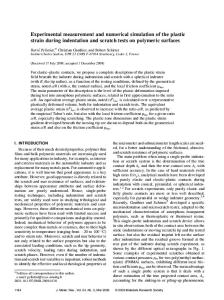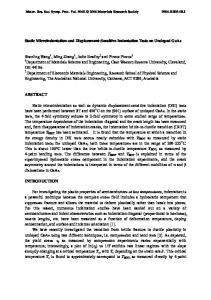Microindentation of titanium: Dependence of plastic energy on the indentation depth and time-dependent plastic deformati
- PDF / 705,938 Bytes
- 8 Pages / 585 x 783 pts Page_size
- 76 Downloads / 351 Views
M. Ashraf Imam, C.R. Feng, and Peter Pao Material Science and Technology Division, Naval Research Laboratory, Washington, DC 20375 (Received 23 October 2007; accepted 4 January 2008)
The cavity model and the dislocation mechanics were used to analyze the plastic energy dissipated in an indentation deformation. The plastic energy dissipated in an indentation cycle was proportional to the cube of the residual indentation depth. The experimental results supported the analysis for the indentation of commercially pure titanium by a Vickers indenter. Slip bands around the indentation were observed, suggesting that the indentation deformation was controlled by dislocation motion. The indentation hardness decreased with the indentation load, showing the indentation size effect. The ratio of the total energy to the plastic energy was found to be proportional to the ratio of the maximum indentation depth to the residual indentation depth. The effects of holding time were examined on the time-dependent plastic deformation of the commercially pure titanium at ambient temperature.
I. INTRODUCTION
Titanium and its alloys are important structural materials with low density, high specific strength, and good corrosion resistance. They have been widely used in many varieties of applications in aerospace, military, and biomedical devices. It is of technological importance to study the mechanical behavior of titanium and understand its deformation behavior. In last several decades, the plastic deformation of pure titanium has been studied extensively. Akhtar and Teghtsoonian1,2 showed that the plastic flow of single crystal Ti has three stages of hardening due to the interaction between dislocations and interstitial atoms at temperatures between 77 and 1120 K and a strain rate of 10−4/s. Nemat-Nasser et al.3 evaluated the compression deformation of commercially pure titanium (CP-Ti) over a temperature in the range of 77 to 1000 K and a strain rate in the range of 10−3 to 8 × 103 s−1. They observed strong dependence of the plastic flow on temperature and strain rate with the deformation pattern exhibiting two-stage behavior at low temperatures, three stages in the temperature range of 296 to 800 K, and one stage over 800 K. They suggested that the deformation of titanium was controlled by dislocation motion, while both strain aging and deformation twina)
Address all correspondence to this author. e-mail: [email protected] DOI: 10.1557/JMR.2008.0140 1068
J. Mater. Res., Vol. 23, No. 4, Apr 2008
ning needed to be taken into account in the analysis of plastic flow. Tsuchiya et al.4 measured the Young’s modulus and tensile strength of sputtered titanium thin films and concluded that the mechanical properties of the titanium films were a function of the film texture. A detailed review can be found in Ref. 5. Indentation testing is a technique to characterize localized mechanical behavior of materials. The advantages of using the indentation test involve the use of a small amount of materials and possibly evaluate local deformation o
Data Loading...











